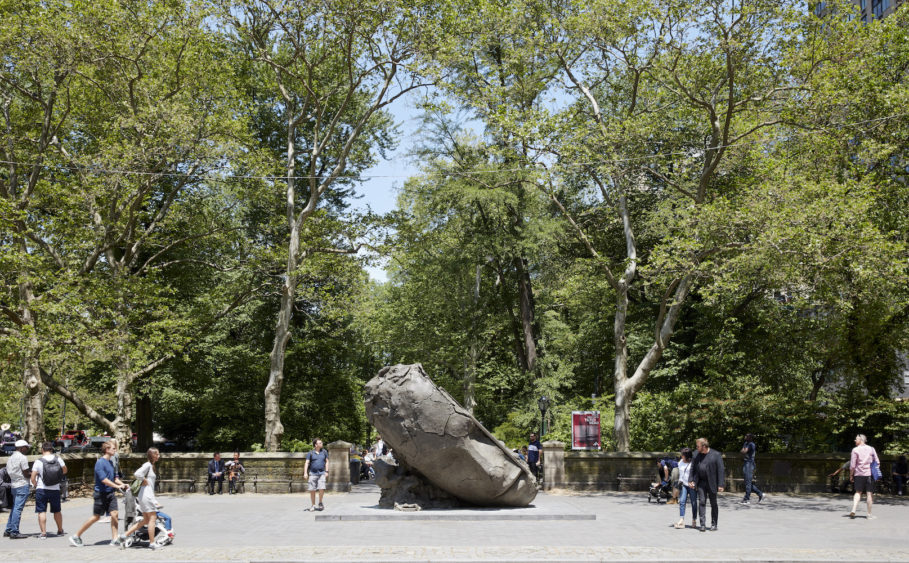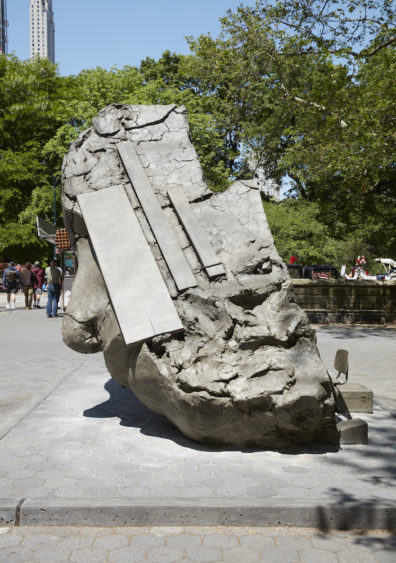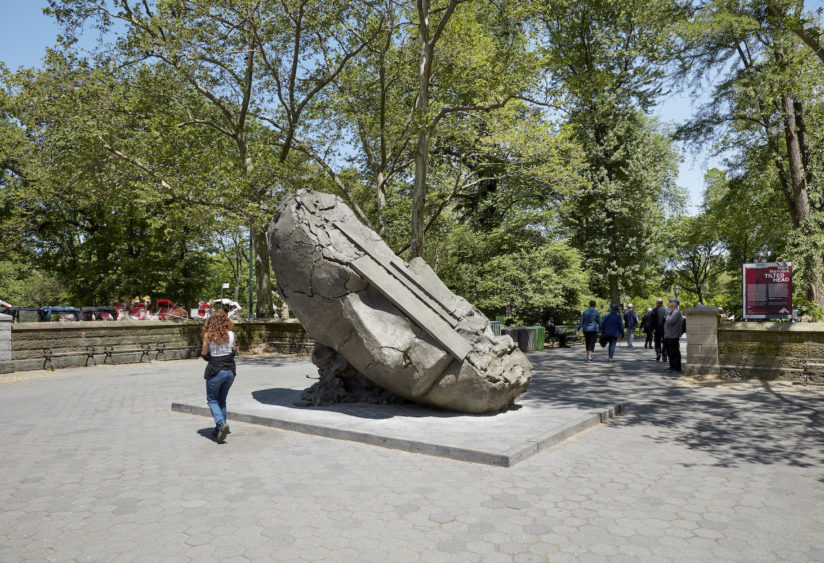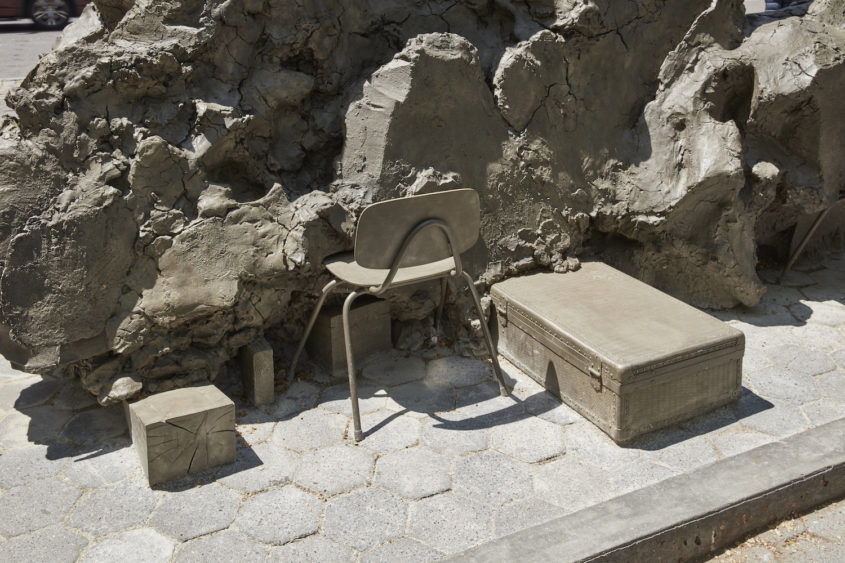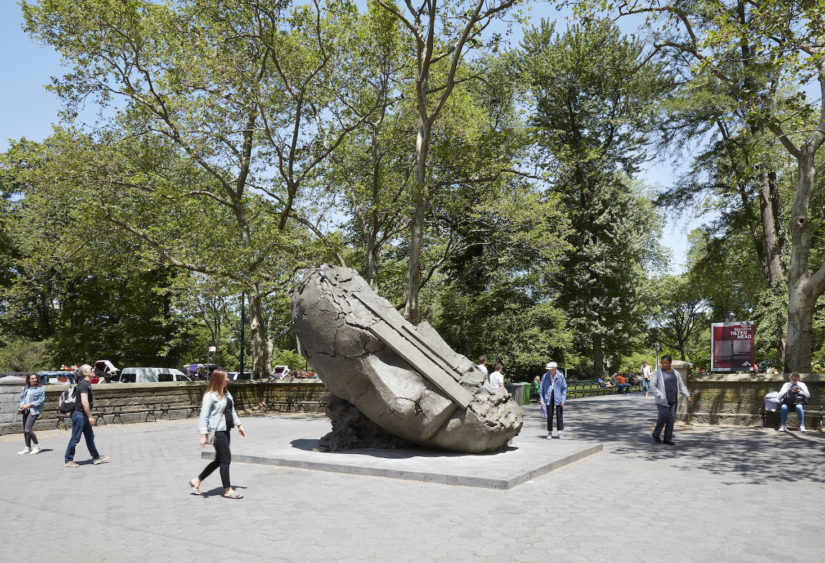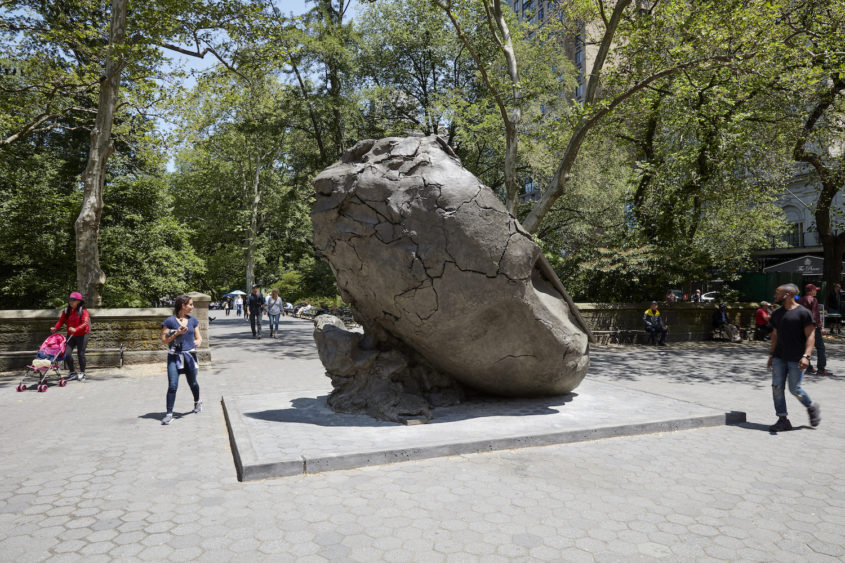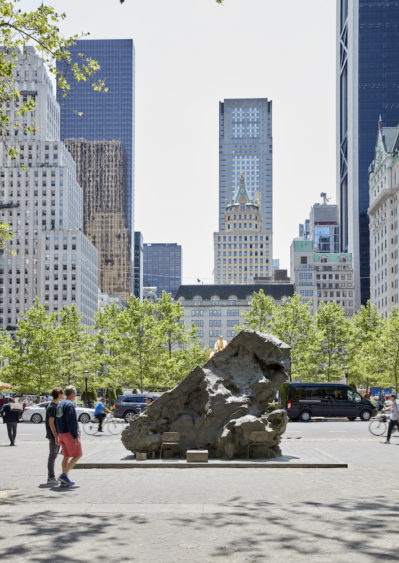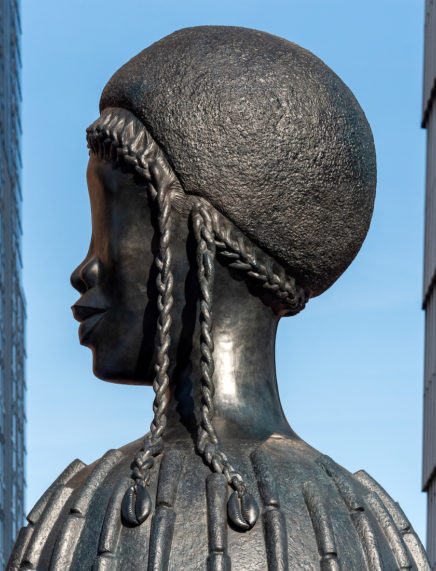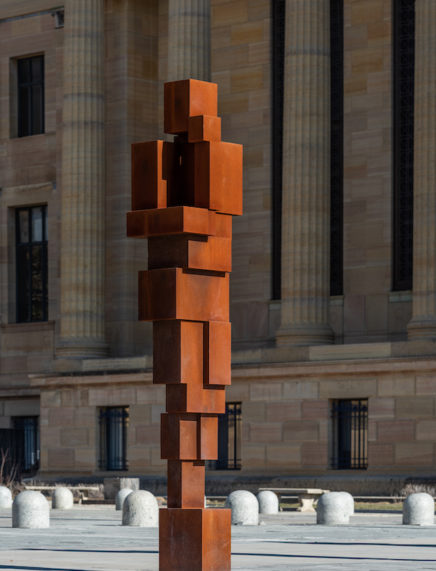Mark Manders : Tilted Head
The Dutch artist Mark Manders, just over fifty, is offering a monumental head directly north of the small plaza where 59th Street and Fifth Avenue intersect. Manders has an established reputation in Europe; in 2013, he represented Holland at the Venice Biennale. This work is formidably mysterious, even formidably so. It consists of an androgynous head, one third (the right side) of which has been sliced off; this truncated flank of the head is seemingly supported by several wooden planks propping up what looks like clay material composing the entire sculpture (in fact, the sculpture has been cast in bronze). At the back of the head, one views what looks like clay, complete with cracks and rough edges separating the rough masses of materials. At the base of the back of the work, two schoolroom chairs and two suitcases, both a bit smaller than life-size, have been inserted into the rough mass of seeming clay. It is an odd work of art, notable for its idiosyncrasy–as well as its complicated and indeed opaque relationship to one of the busiest meeting points in the city. Certainly, the front of the head, the face, is sensitively established. But the abrupt cut into the head, along with the odd supports and rough, material-oriented background, make it a work of aggressive detachment, in a city known for its aggressive indifference. And maybe that is the point.
We are in a strange position now in regard to contemporary public sculpture–there is a concerted effort, at least in America, to democratise culture, a position that leads to an unwillingness to apotheosize anyone but transparent martyrs. In the case of Manders’ work, we are faced with an entirely anonymous person, not only of indeterminate rank but also of sex. What is Manders’ audience to make of a sculpture that takes on a public aura but refers to no one in particular? Isn’t it a bit more than strange? The creative intelligence evidence in the work refers to a postmodern idiom, in which creative figuration vies with historical positioning, in both a thematic and materials sense. So the old and the new are merged here, just as clay, the oldest material we have in the production of sculpture, becomes bronze, another very old substance used in three-dimensional art but belonging to metal rather than dirt. And how are we meant to interpret a sculpture that that is partly realistic, partly abstract (or at least unformed), and partly conceptual, in the sense that the small chairs and suitcases seem like an attempt to establish a different, indoor and even alienated, alienating reality into the gestalt of a traditional head? It is all rather odd, but to repeat my comment, maybe that’s the point.
To place so complicated a work of art in the center of New York’s midtown, a place where commerce, tourism, and even nature (in the form of Central Park) meet. Is to take a chance that the art will not be noticed or fully respected. In fact, this is true–someone had left a plastic cup half filled with a drink on the seat of the chair inserted into the back of Manders’ Tilted Head. This bit of casual but deliberate disregard seems perfect for the current cultural climate of New York, in which high art aspirations are disparaged in favour of a much rawer scene. Anyone traveling in that neighborhood is going to meet up with the near anarchy of highly disparate populations connecting much more with immediate experience, in the form of food and drink especially, rather than going about studying a complex sculptural image whose references and implications remain obscure. Manders may want to have it both ways–he may feel the necessity, for a project like this, of the suggestion of something approaching grandeur. But, at the same time, he is an artist working at a moment in time when grandeur is distinctly an esthetic and political disadvantage, determined as we are to erase privilege or historical distinction. So the very notion of remembering a person seems to carry with it a certain discomfort, an ethical wariness aimed at the very notion of achievement. This is a strange situation to make art in, but these are the current cultural circumstances of American thinking.
In fact, there is not much we can do to place Tilted Head on a transcendent plane. As we have noted, the face is sensitive, even beautiful, but its gender is determinate. And the detritus behind the face–its unformed structure and meaningless additions that have nothing to do with the creation of something memorable–deliberately undermine notions of class and the nobility of history. It is–and this is said with sadness–a memorial for our time. If the head is fragmented to the point of denotative absurdity, and if we have no idea what the public role we might assign it could be, its aura remains neutral and conspicuously indirect. Maybe Manders is determined to create an anti-monument, in which size is undercut by thematic confusion. We are unable to place his creative impulses within a specific historical context. This not only means that the sequence of events that we call historical can be looked at with suspicion, because it has been privileged to be thought of in this ways, it also indicates that any attempt to commemorate an event is politically, even ethically, suspect. In the absence, though, of a memory supported by sculpture, we have a void, in which a plastic cup of soda embellishes a sculpture that makes no sense.
Can anything be done to erase our erasure of memory? American culture long ago internalised the war cry of the Sixties–”The personal is political.” This is starting to look like a major mistake: we use the imperfections of public people’s private lives as a lever to drive them out of power. We do this now instead of confronting the public stance of the people whose ideas we disagree with. As a result, political differences–or the discussion of them–have been marked by pettiness and vindictive malice. Maybe Manders is looking for a way out of the dilemma that we have created as we substitute gossip for intellectual confrontation. In a way, if we think about it, his sculpture indulges in gossip by exposing the crudeness of what lies behind the beautiful head. We needn’t see things this way, but the belief that a rotten interior exists behind a glorious facade is part of the spirit of the time. Idealism has been replaced by the conscious attempt to see it as just another failed attempt to transcend our fallen condition. But, interestingly, the head’s majesty is not entirely destroyed. Its traces of deliberate beauty–and, indeed, its genuine gravitas–cannot be entirely defaced–even if the artist himself has attempted to do so. In American culture, and increasingly all over the world, transcendence has fallen out of favor. But that hardly means it is extinct or forever banished. Beauty crops up where it will, suggesting something better than what we have at hand. Manders does this wonderfully well, even if it makes sense to suggest he does so unknowingly.
Mark Menders : Tilted Head
Until September 1st 2019
New York
